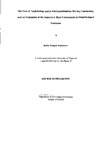The Fate of Naphthalene and n-Alkylnaphthalenes During Combustion, and an Evaluation of the Sources of these Compounds in Diesel Exhaust Emissions
| dc.contributor.author | Pemberton, Robin Douglas | |
| dc.contributor.other | School of Geography, Earth and Environmental Sciences | en_US |
| dc.date.accessioned | 2013-11-13T11:43:53Z | |
| dc.date.available | 2013-11-13T11:43:53Z | |
| dc.date.issued | 1996 | |
| dc.identifier | NOT AVAILABLE | en_US |
| dc.identifier.uri | http://hdl.handle.net/10026.1/2684 | |
| dc.description.abstract |
The main objective of this research was to understand the fate of naphthalene and n-alkylnaphthalenes during diesel combustion, and an evaluation of their sources in diesel exhaust emissions. This was achieved by the use of a procedure which employed a [14C]radiolabelled PAH technique and a diesel enriched fuel technique (DEFT). The combustion of diesel fuel spiked with [14C]naphthalene has shown unequivocally that 0.5% of the naphthalene contained in diesel fuel survives combustion under the engine conditions studied (2500 rpm and 50 Nm). The survived naphthalene represented 22.8% of the total recovered naphthalene, the other 77.2% was presumably pyrosynthetic in nature. The sources of the pyrosynthesised naphthalene in the emissions was investigated at 2500 rpm and 50 Nm. The previously unreported input of n-methylnaphthalenes to the pyrosynthesised naphthalene was demonstrated by combusting fuel spiked with [14C]2-methylnaphthalene. Radiolabelled 2- methylnaphthalene (0.53% of the original [14C]2-methylnaphthalene) which had survived combustion, and radiolabelled naphthalene (0.02% of the original [14C]2-methylnaphthalene), were recovered in the exhaust extracts. This showed unequivocally that 2-methylnaphthalene was converted to naphthalene in the combustion chamber. The first enrichment experiments (DEFT), in which 1- and 2-methylnaphthalene were added separately to fuel prior to combustion confirmed that demethylation of both species produced naphthalene in small yields (1.9% and 6.1% respectively). The contribution of n-alkylnaphthalenes with the alkyl group greater than methyl in length, to pyrosynthesised naphthalene contained in exhaust emissions was investigated using fuel spiked with non-radiolabelled alkyl-PAH. The major product of combustion of these compounds was 2- vinylnaphthalene, with a 0.08% conversion for 2-butylnaphthalene and a 0.01% conversion for 2- ethylnaphthalene. No dealkylated products were detected in the exhaust emissions. A mechanism for the formation of 2-vinylnaphthalene was proposed. The effect of engine speed and load on the recovery of naphthalene and the contribution of pyrosynthesised and survived naphthalene to recovered naphthalene were established using [14C]naphthalene. At all speeds and loads investigated the pyrosynthesised fraction of recovered naphthalene was shown to be dominant. | en_US |
| dc.language.iso | en | en_US |
| dc.publisher | University of Plymouth | en_US |
| dc.title | The Fate of Naphthalene and n-Alkylnaphthalenes During Combustion, and an Evaluation of the Sources of these Compounds in Diesel Exhaust Emissions | en_US |
| dc.type | Thesis | |
| plymouth.version | Full version | en_US |
| dc.identifier.doi | http://dx.doi.org/10.24382/4400 | |
| dc.identifier.doi | http://dx.doi.org/10.24382/4400 |
Files in this item
This item appears in the following Collection(s)
-
01 Research Theses Main Collection
Research Theses Main


